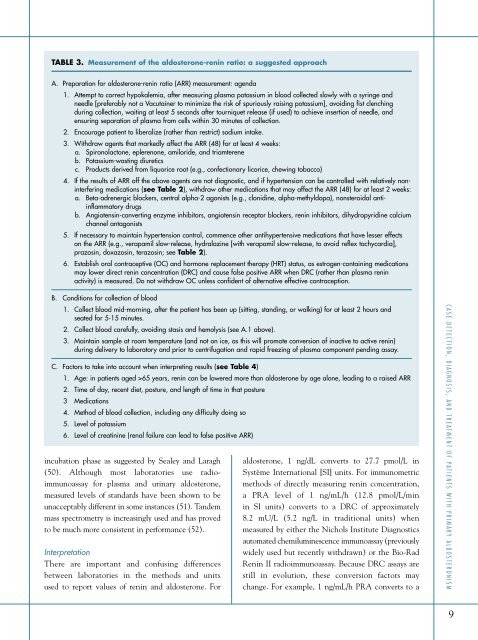GUIDELINES - The Endocrine Society
GUIDELINES - The Endocrine Society
GUIDELINES - The Endocrine Society
You also want an ePaper? Increase the reach of your titles
YUMPU automatically turns print PDFs into web optimized ePapers that Google loves.
TABLE 3. Measurement of the aldosterone-renin ratio: a suggested approachA. Preparation for aldosterone-renin ratio (ARR) measurement: agenda1. Attempt to correct hypokalemia, after measuring plasma potassium in blood collected slowly with a syringe andneedle [preferably not a Vacutainer to minimize the risk of spuriously raising potassium], avoiding fist clenchingduring collection, waiting at least 5 seconds after tourniquet release (if used) to achieve insertion of needle, andensuring separation of plasma from cells within 30 minutes of collection.2. Encourage patient to liberalize (rather than restrict) sodium intake.3. Withdraw agents that markedly affect the ARR (48) for at least 4 weeks:a. Spironolactone, eplerenone, amiloride, and triamtereneb. Potassium-wasting diureticsc. Products derived from liquorice root (e.g., confectionary licorice, chewing tobacco)4. If the results of ARR off the above agents are not diagnostic, and if hypertension can be controlled with relatively noninterferingmedications (see Table 2), withdraw other medications that may affect the ARR (48) for at least 2 weeks:a. Beta-adrenergic blockers, central alpha-2 agonists (e.g., clonidine, alpha-methyldopa), nonsteroidal antiinflammatorydrugsb. Angiotensin-converting enzyme inhibitors, angiotensin receptor blockers, renin inhibitors, dihydropyridine calciumchannel antagonists5. If necessary to maintain hypertension control, commence other antihypertensive medications that have lesser effectson the ARR (e.g., verapamil slow-release, hydralazine [with verapamil slow-release, to avoid reflex tachycardia],prazosin, doxazosin, terazosin; see Table 2).6. Establish oral contraceptive (OC) and hormone replacement therapy (HRT) status, as estrogen-containing medicationsmay lower direct renin concentration (DRC) and cause false positive ARR when DRC (rather than plasma reninactivity) is measured. Do not withdraw OC unless confident of alternative effective contraception.B. Conditions for collection of blood1. Collect blood mid-morning, after the patient has been up (sitting, standing, or walking) for at least 2 hours andseated for 5-15 minutes.2. Collect blood carefully, avoiding stasis and hemolysis (see A.1 above).3. Maintain sample at room temperature (and not on ice, as this will promote conversion of inactive to active renin)during delivery to laboratory and prior to centrifugation and rapid freezing of plasma component pending assay.C. Factors to take into account when interpreting results (see Table 4)1. Age: in patients aged >65 years, renin can be lowered more than aldosterone by age alone, leading to a raised ARR2. Time of day, recent diet, posture, and length of time in that posture3 Medications4. Method of blood collection, including any difficulty doing so5. Level of potassium6. Level of creatinine (renal failure can lead to false positive ARR)incubation phase as suggested by Sealey and Laragh(50). Although most laboratories use radioimmunoassayfor plasma and urinary aldosterone,measured levels of standards have been shown to beunacceptably different in some instances (51). Tandemmass spectrometry is increasingly used and has provedto be much more consistent in performance (52).Interpretation<strong>The</strong>re are important and confusing differencesbetween laboratories in the methods and unitsused to report values of renin and aldosterone. Foraldosterone, 1 ng/dL converts to 27.7 pmol/L inSystème International [SI] units. For immunometricmethods of directly measuring renin concentration,a PRA level of 1 ng/mL/h (12.8 pmol/L/minin SI units) converts to a DRC of approximately8.2 mU/L (5.2 ng/L in traditional units) whenmeasured by either the Nichols Institute Diagnosticsautomated chemiluminescence immunoassay (previouslywidely used but recently withdrawn) or the Bio-RadRenin II radioimmunoassay. Because DRC assays arestill in evolution, these conversion factors maychange. For example, 1 ng/mL/h PRA converts to aCASE DETECTION, DIAGNOSIS, AND TREATMENT OF PA TIENTS WITH PRIMARY ALDOSTERONISM9


